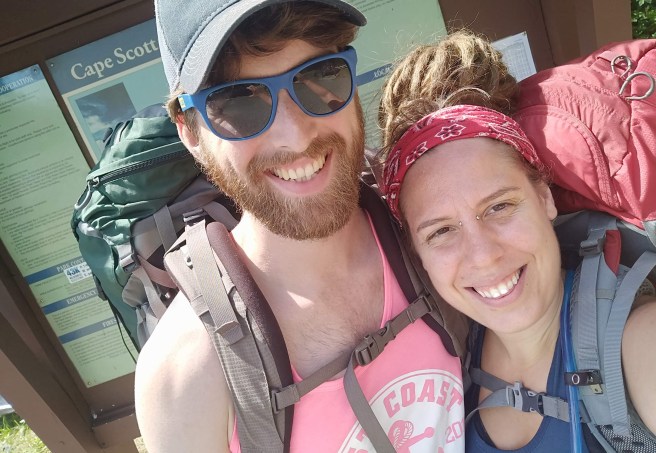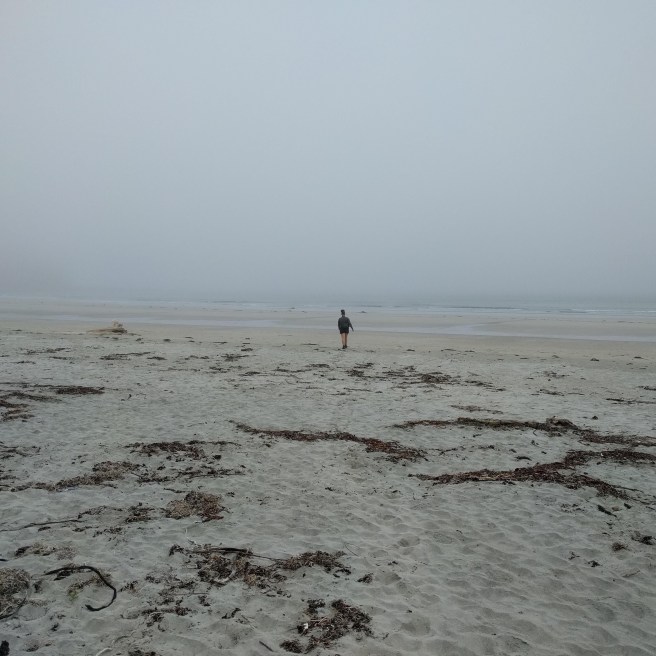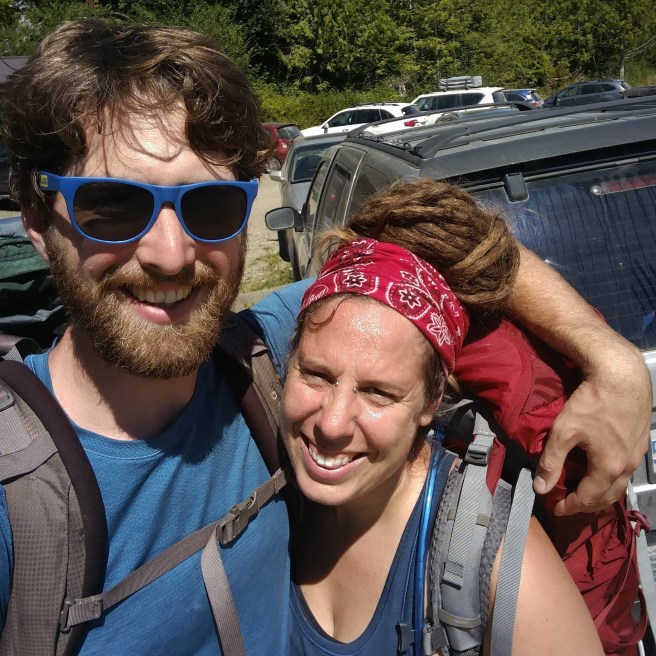Nobody should ever describe a trip to Cape Scott Provincial Park as ‘quick’. Cape Scott occupies the northern west tip of Vancouver Island and the western reach of the North Coast Trail (the younger, muddier sister of the world famous West Coast Trail). It is a long drive from Victoria (or any of the urban centres on Vancouver Island) and a bit of a slog to the beautiful northern beaches and, ultimately, the Cape Scott Lighthouse.
Day 1: Trailhead to Nels Bight
After a long drive, from one end of Vancouver Island to the other, my partner and I finally arrived at the parking lot for the trailhead. It was packed! Almost every spot was taken , and there were people parked on the shoulders of the road and blocking each other in to their rogue parking spaces. There were 60+ vehicles, each carrying an unknown number of passengers. People were milling about, returning from a long trek and getting their gear sorted before departing on the long drive home, or getting geared up and putting on all the sunscreen, mosquito repellent, foot treatments and body tape that could be imagined.
The crowning jewel of the mayhem was, of course, the people in flipflops and sneakers wearing two backpacks (one on the back and one on the front), and carrying shopping bags of pillows, hotdogs, and stoves. Naturally, we felt wildly over-prepared with our good hiking boots, single, light backpack, and gaiters. After reading some sign posts we discovered that there was a popular camping area in San Josef Bay, less than two kilometres from the trailhead. Clearly the goal of these casual campers was to enjoy the beautiful San Josef Bay, so we felt far less self-conscience.

We left the trailhead at approximately 14:00 with a bounce in our steps, and 16.8 kilometres of trail ahead of us. The trail starts off as a wide comfortable gravel path through a beautiful old forest. The region was logged at least once before, and you can see ancient evidence of massive stumps and fallen timbers. Blanketed by moss, medium sized trees grow on the decaying remains of the abandoned logs.
The trail soon reaches a T-intersection: left to San Josef Bay, and right to head to Eric Lake, Nels Bight and Cape Scott. 15.9 km to go. Beyond the well groomed, gravel path to San Josef Bay, the trail became narrow with plenty of tripping hazards. We were fortunate that our trip coincided with a dry spell (although it’s also depressing, because more and more Vancouver Island summers are dry for months…); had the trail been muddy and wet, the footing could have been incredibly slippery and treacherous for anybody with less than excellent balance and footwork.
Although the trail was fairly shady and flat, the first few kilometres seemed to pass slowly and painfully. Our bodies had not carried heavy backpacks for close to a year (it was an unusually sedentary winter/spring/summer) and it took the first five kilometres to get adjusted. Once we were lightly numb and had hit out stride, the kilometers seemed to slip by and we could greatly enjoy the flat, scenic trail.

The history of Cape Scott is fascinating, peculiar, and rather disappointing. There is limited information about the First Nation communities that populated the region originally. At the turn of the 19th century, the first white settlers arrived, mostly of Danish decent. At the time, there was an understanding with the government that a road would be built from the nearby community of Holberg. When the government abandoned plans for the road, the original settlers left, due to extreme conditions and inaccessibility. A second wave of settlers arrived in 1913 and at it’s peak, Cape Scott was home to almost 1000 people. Again, the second wave of settlers abandoned the region for the same reasons as the first: extreme conditions and a lack of accessibility. As we approached the original settlements, there was increasing evidence of previous human intervention: old pieces of farm post, bits of corduroy road, and cleared fields that have been all but reclaimed by the busy forest.
After approximately twelve kilometres there was an intersection in the trail: straight ahead to Nissan Bight (two more kilometres) or left to the old settlement, Nels Bight and Cape Scott (four more kilometres). Although we had been cruising at a comfortable clip, our feet were starting to get tired and our legs were feeling heavy. The Cape Scott Lighthouse was almost seven kilometres past Nels Bight, so if we stayed at Nissan Bight we would be looking at a nearly 20 kilometre hike the following day. Ug. Instead we decided to push ourselves a little further and continue on to Nels Bight.
We pushed ourselves to walk as quickly as we could, anxious to get to the beach, take our boots off, and lie in the sand. We barely paused when we reached the old settlement, marked with an interpretive panel, a few rusted bits of old tools, and a mound of moss-covered lumber. We did stop briefly when we arrived at Hansen’s Lagoon. My partner had never been there before, and was shocked (as I was the first time), emerging from the dense forest into a wide, flat, open field. The fields were the result of dykes built by the original Danish settlers to reclaim parts of the fertile estuary for farming purposes. Those dykes still stand today, and deep channels tame enthusiastic waterways and guide them to Hansen’s Lagoon.
Not far after the fields, we made it to Nels Bight, happy, tired, and very satisfied. We were both very keen to devour some dinner, and crawl into the tent, ready to get a good sleep before a beautiful walk to Cape Scott.

Day 2: Nels Bight to Cape Scott (and back to Nels Bight)
The next day on the trail dawned cool, misty, and beautiful. We were both rather tired after the long hike the previous day, so we had allowed ourselves the luxury of going to bed without an alarm or any urgent plans. Our only real goal was to make it all the way to Cape Scott; it being only seven kilometres away and having all day, there was no real urgency in our day.
After a leisurely breakfast, we departed towards the cape. We were delighted to see the sun start to burn off the cloud cover, and we ended up spending most of the day in intermittent cloud cover. Much of the route past Nels Bight was beach walking and although walking along the beaches is beautiful, it is also extra tough on the legs, especially when they were feeling tired from the day before. A well kept secret, the beaches of northern Vancouver Island are absolutely stunning. The sand is almost white, and the water is layers of turquoise and teal, in many ways rivalling a tropical destination. Granted, it is quite the walk to arrive at the beach (although that also keeps the hordes at bay), the weather is usually mediocre at best, and the water is icy cold.

During the Second World War, Cape Scott was the site of a secret radar station to monitor for Japanese aircrafts. During operation, the radar station was manned by 50 people who all arrived by boat. The final trail as we approached the lighthouse is the old road built by the military over 70 years ago. The telegraph lines also still stand, which look wildly out the place in the windswept forest, thick with salal. After puttering along the old abandoned road, we soon popped out on a wide well-maintained dirt road, which lead us directly to the lighthouse.
Every lighthouse I have visited looks and feels almost identical: a cluster of little white buildings with poppy-red trim and a well maintained lawn huddle together on a deserted cape, accessible via boat or long hike rather than any kind of a road. We met the lighthouse keeper, Dave, and chatted with him for a while. There are very few manned lighthouses still operating in Canada (I think the number cited was 27) and, as you can imagine, they are the remote, difficult to access lighthouses. The Cape Scott lighthouse is actually one of the most popularly visited lighthouses, due to the relatively easy accessibility via the hiking trail
The lighthouse keeper had previously been posted at a particularly remote lighthouse and was beyond delighted to have a steady stream of friendly visitors. He sat out on his porch and shared all kind of outrageous stories about the goings on in the middle of nowhere. He also allowed us to climb the lighthouse and see what we could see. The answer is clouds. The coastal mist hung to the cape and we could see a lot of grey.

We headed back to our campsite, after a snack and a lovely visit. Some advice from another hiking group suggested that rather than following the trail back to Nels Bight we follow the beach exclusively and explore the sea stacks. Off we went, cheerfully following the beach and exploring the tiny caves and stacks nestled between the ancient forests and clean sand. Rounding the corner from one such cave, we looked up to see a happy bear sitting in a low-tide zone, not 50 meters from us! We stared and him, and he stared at us…and then he went back to snacking on the grub in the seaweed. Talking loudly did not encourage him to wander off, and instead he looked up from his snack, glared at us, and went back to snacking away. The route forward required passing not 10 feet from the bear, so rather than pushing on, we sat down on a nearby log and watched him putter away. After half an hour or so, when he showed no signs of moving on, we backtracked to the ‘official’ trail and followed it back to our campsite without incident.

Day 3: Nels Bight to Victoria
On our last day on the beach I learned just how many sand fleas lived on the beach. We estimated it would take over twelve hours from leaving the beach to arriving at our cozy apartment so we planned to get up at dawn, pack up camp, and hustle back to the truck.
So, in the early dawn light we crawled out of our tent and I headed off across the beach to the bear cache to collect our food…and learn a to about beach insects! The entire beach was writhing with small sand lice and large California beach hoppers that crunched and squished underfoot. It was horrifying and something out of a Fear Factor challenge! And I couldn’t avoid them. No matter how carefully I placed my feet I would step on a few, and if I walked fast without looking down I stepped on them as well. Ugh. As the day brightened, the little suckers disappeared back under the sand (thankfully!) and by the time I was returning from the cache (a mere few minutes) they had mostly dissipated. But oh man, what a horror!

The rest of our packing up went quickly and well: we downed our breakfast, stuffed out tent into it’s bag, and organized our bags with all the necessary snacks at easy-to-reach locations. And then, as he walked over to grab his socks for our imminent departure, my partner thwacked his toe into a big piece of driftwood. After hopping around on one foot, and some muffled swearing, we examined the toe and it did not appear permanently damaged or broken, just very very painful. Unfortunately there were not a lot of options for us other than for sucking it up and walking out, albeit a bit slower than we intended. So off we went.
The walk back to the truck seemed much faster – we hit our pace quickly in the beautiful dew-covered morning and cruised along, listening to wolves howl in the distance. I love seeing bears in the forest, but I would never want to see a wolf. It was incredible to pass back through Hansens Lagoon and the old Danish settlement and imagine what it would have been like 100 years ago to walk the same path.
Upon arrival at the intersection between Nissan Bight, Nels Bight, and the trailhead, we stopped and explored a few well worn paths. One path lead to the remnant foundations of an old house and a surprisingly new granite tombstone of a child that had died at the age of 12. Ancestors had returned and installed the tombstone recently. The second path lead to a tiny, abandoned graveyard that held decrepit wooden tomb markers and mossy mounts of earth – a rather sad conclusion to a failed community.
On we walked, cruising past the kilometres and seeing nobody. After a few kilometres, my partner mentioned his throbbing toe that had been smacked as we left the campground. After some more kilometres, I started to notice him walking with a subtle limp, and eventually a pronounced limp. When we stopped at our final rest stop before the final few kilometres, we decided that he should more certainly not take his boots off, incase the toe swelled to the point we couldn’t get the foot back in the boot. Apparently his baby toe felt as large as his big toe!
When we finally arrived at the truck and he gratefully ripped off his boots, the toe was, in fact, almost as large as his big toe and completely black and blue! We poked at it some more, checking for point tenderness or any other signs of a break. Just very very bruised. I wanted to include a picture of my partner’s swollen, black-and-blue toe, but he declined the offer. So instead, here we are: tired, a little sun burnt, and very happy.

Despite being a quick there-and-back trip, Cape Scott was one of our favourite trips. The weather was great, the beach camping was spectacular, and the scenery was breathtaking. We are already planning to return with more time to explore the settlement ruins, the dykes, and maybe even try out the notorious North Coast Trail.

it looks like a great trip for you.
LikeLike
Thanks! It really was 🙂
LikeLiked by 1 person